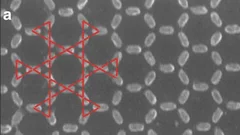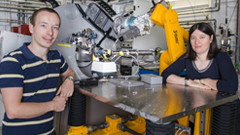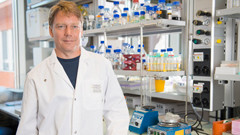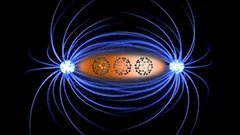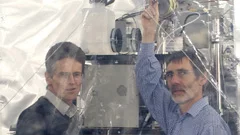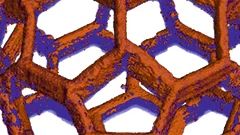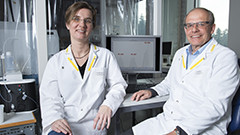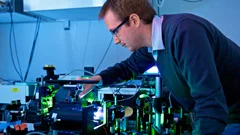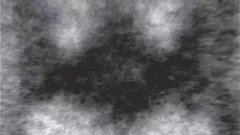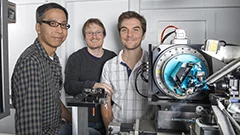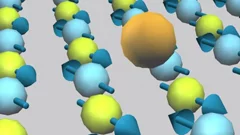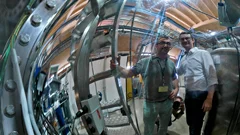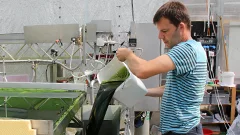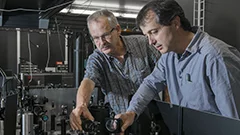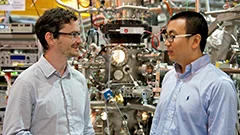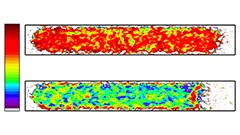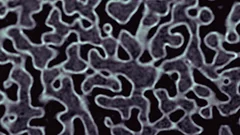Media Releases
Tiny magnets mimic steam, water and ice
Researchers at the Paul Scherrer Institute (PSI) created a synthetic material out of 1 billion tiny magnets. Astonishingly, it now appears that the magnetic properties of this so-called metamaterial change with the temperature, so that it can take on different states; just like water has a gaseous, liquid and a solid state.
The key to charging a lithium-ion battery rapidly
Lithium iron phosphate batteries are very durable and can be charged relatively quickly. Researchers from the Paul Scherrer Institute (PSI), ETH Zurich and Japanese car manufacturer Toyota reveal the reasons for these properties in a new study. The findings were made possible thanks to measurements using a new method at the Swiss Light Source (SLS) at PSI.
New details of the transmission of stimuli in living organisms unveiled
Researchers unveil new details of how cells in a living organism process stimuli. So-called G-proteins, which help conduct external stimuli that reach a cell into its interior, play a central role here. For the first time, the study shows which parts of the G-proteins are vital for their function. Researchers from the Paul Scherrer Institute PSI, ETH Zurich, the pharmaceutical company Roche and the British MRC Laboratory of Molecular Biology report their results in the journals Nature and Nature Structural and Molecular Biology.
Magnets made of non-magnetic metals
For the first time, an international research team has demonstrated how to generate magnetism in metals that aren’t naturally magnetic, such as copper. The discovery could help develop novel magnets for a wide range of technical applications. Crucial measurements to understand this phenomenon were carried out at PSI à the only place where magnetic processes inside materials can be studied in sufficient detail.
Particulate matter from modern gasoline engines damages our lungs
For years, studies have proved that fine dust from petrol engines can damage our health. Modern engine technology does not help, either, as researchers from the University of Bern and the Paul Scherrer Institute (PSI) reveal.
Nanometres in 3D
Scientists at the Paul Scherrer Institute and ETH Zurich have created 3D images of tiny objects showing details down to 25 nanometres. In addition to the shape, the scientists determined how particular chemical elements were distributed in their sample and whether these elements were in a chemical compound or in their pure state.
Gasoline beats mining
Until it was banned, leaded gasoline dominated the manmade lead emissions in South AmericaLeaded gasoline was a larger emission source of the toxic heavy metal lead than mining in South America à even though the extraction of metals from the region’s mines historically released huge quantities of lead into the environment. Researchers from the Paul Scherrer Institute PSI and the University of Bern have discovered evidence of the dominance of leaded gasoline based on measurements in an ice core from a Bolivian glacier. The scientists found that lead from road traffic in the neighbouring countries polluted the air twice as heavily as regional mining from the 1960s onwards. The study is to be published in the journal Science Advances on 6 March 2015.
New laser for computer chips
Germanium-Zinn-Halbleiterlaser lässt sich direkt auf Siliziumchips aufbringenWinzige Laser, die in Computerchips aus Silizium eingebaut werden, sollen in Zukunft die Kommunikation innerhalb der Chips und zwischen verschiedenen Bauteilen eines Computers beschleunigen. Lange suchten Experten nach einem dafür geeigneten Lasermaterial, das sich mit dem Fertigungsprozess von Siliziumchips vereinbaren lässt. Wissenschaftler des Forschungszentrums Jülich und des Paul Scherrer Instituts PSI haben hier nun einen wichtigen Fortschritt erzielt.This news release is only available in German.
Batman lights the way to compact data storage
Researchers at the Paul Scherrer Institute (PSI) have succeeded in switching tiny, magnetic structures using laser light and tracking the change over time. In the process, a nanometre-sized area bizarrely reminiscent of the Batman logo appeared. The research results could render data storage on hard drives faster, more compact and more efficient.
Shortcut to protein portraits
All living organisms, from bacteria to humans, rely on proteins to perform their vital functions. How these proteins accomplish their tasks depends on their structure. Researchers from the Paul Scherrer Institute have now devised a novel method to determine the crystal structure of proteins using X-ray light, which could also hasten the development of new drugs in future. The study will be published in the journal Nature Methods on 15 December.
When thawing glaciers release pollutants
As glaciers increasingly melt in the wake of climate change, it is not only the landscape that is affected. Thawing glaciers also release many industrial pollutants stored in the ice into the environment. Now, within the scope of a Swiss National Science Foundation project, researchers from the Paul Scherrer Institute (PSI), Empa, ETH Zurich and the University of Berne have measured the concentrations of a class of these pollutants à polychlorinated biphenyls (PCB) à in the ice of an Alpine glacier accurately for the first time.
Puzzling new behaviour observed in high-temperature superconductors
New effect might be important for emergence of High-Temperature SuperconductivityAn international team of researchers has observed a new, unexpected kind of behaviour in copper-based high-temperature superconductors. Explaining the new phenomenon à an unexpected form of collective movement of the electrical charges in the material à poses a major challenge for the researchers. A success in explaining the phenomenon might be an important step toward understanding high-temperature superconductivity in general. The crucial experiments were conducted at the Paul Scherrer Institute.
Useful for spintronics: Big surprises in a thin surface region
The need for ever faster and more efficient electronic devices is growing rapidly, and thus the demand for new materials with new properties. Oxides, especially ones based on strontium titanate (SrTiO3), play an important role here. A collaborative project headed by scientists from the PSI has now revealed properties of strontium titanate that make it an important base material for applications in spintronics.
Airpocalypse explained
The causes of China's record level fine particulate pollution in winter 2013 At the beginning of 2013 a greyish-brown blanket of smog lay over large areas of China for several months. The fine particle pollution was higher by 1 to 2 orders of magnitude than the levels normally measured in Western Europe and the United States. An international team of researchers under the lead of the Paul Scherrer Institute PSI and the Institute of Earth Environment, Chinese Academy of the Sciences revealed the causes of the airpocalypse. The study published in the journal Nature also describes what steps are to be taken to prevent an environmental crisis of this kind in the future.
Energiewende in Reinkultur – in Wädenswil zu bestaunen
Der am Paul Scherrer Institut PSI entwickelte Prozess der hydrothermalen Methanierung von wässriger Biomasse erreicht einen wichtigen Meilenstein: Dank der Zusammenarbeit im neuen Kompetenzzentrum des Bundes für Bioenergie BIOSWEET konnten Forschende des PSI, der ZHAW, der ETH Lausanne, der Empa und der Hochschule für Technik Rapperswil die technische Machbarkeit der Methanherstellung aus Mikroalgen demonstrieren. Der dazu verwendete Algenbioreaktor sowie die Anlage zur Methanierung der Algen können am 24. September auf dem Campus Grüental der ZHAW in Wädenswil besichtigt werden. Für Medienschaffende gibt es von 14:00 bis 14:30 eine spezielle Führung.This news release is only available in German.
New material generated with light
PSI researchers garner experience for SwissFEL experimentsAided by short laser flashes, researchers at the Paul Scherrer Institute have managed to temporarily change a material’s properties to such a degree that they have à to a certain extent àcreated a new material. This was done using the x-ray laser LCLS in California. Once the PSI x-ray laser SwissFEL is up and running, experiments of this kind will also be possible at PSI.
Jurassic Welsh mammals were picky eaters, study finds
New analyses of tiny fossil mammals from South Wales are shedding light on the function and diets of our earliest ancestors, a team led by researchers from the Universities of Bristol and Leicester report in the journal Nature. The team used CT scanning with synchrotron X-rays at PSI’s Swiss Light Source to reveal in unprecedented detail the internal anatomy of the mammals’ tiny jaws.
Insulator makes electrons move in an ordered way
Researchers at the PSI, the EPFL and the Chinese Academy of Science, have proven that the material SmB6 shows all the properties of a so called topological insulator à a material with electric currents flowing along its surface with all of them being polarized. Here, the property is very robust, i.e. the only current that can flow is spin polarized and is not easily destroyed by small irregularities in the structure or composition of the material. Spin polarized currents are necessary for spintronics, electronics using the electrons’ spin.
Ice in fuel cells imaged directly for the first time
Researchers from the Paul Scherrer Institute (PSI) have succeeded in imaging the distribution of frozen and liquid water in a hydrogen fuel cell directly for the first time. They applied a new imaging technique that uses successively two beams with different neutron energies to distinguish between areas with liquid water and those with ice extremely reliably. The method therefore opens up the prospect of studying one of the main problems of using fuel cells to power vehicles: ice can clog the pores in the fuel cells and affect their performance. The PSI scientists’ results will be published in the journal Physical Review Letters on 16 June 2014.
Sixteen nanometres in 3D
Researchers from the Paul Scherrer Institut (PSI) have devised a method that opens up new scales of tomographic imaging and will thus allow in the future highly resolved measurements of biological and materials science specimens. With the aid of a special prototype instrument at the Swiss Light Source (SLS), they achieved a 3D resolution of sixteen nanometres in a large sample and thus set a new world record in X-ray tomography.
